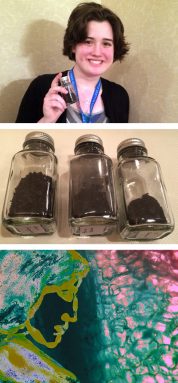Intel STS finalist brings earthworms to the big time
Anne Merrill shows how worms and charcoal help plants grow in Intel Science Talent Search
WASHINGTON — Anne Merrill, 17, has always liked earthworms. “When I was a little kid,” she explains, “I was always stuffing worms in my pockets. My mom learned to be very careful washing my clothes.” Now, the senior at Greenwich High School in Connecticut is taking worm research to the big time at the Intel Science Talent Search.

Anne is interested in finding all-natural ways to prevent fungi from attacking crops. She also wanted to stop the spread of bacteria like Escherichia coli, better known as E. coli. Crops tainted with those germs have led to several food-poisoning outbreaks in people.
For her studies, Anne decided to look at different types of biochar. When mixed into soil, this charcoal can help hold carbon and nitrogen near roots, where plants can use them. And what better way to mix biochar into soil than with a hungry burrowing earthworm?
The teen chose the Canadian nightcrawler, Lumbricus terrestris. It surfaces at night to eat leaf debris and other food. Then it descends by day into the soil for safety. When the food comes out the other end of these worms, those “castings” deposit nutrients. In the process, the worm’s burrowing also loosens dirt. So worms should be able to mix soil up as they bring nutrients underground.
But to confirm that, Anne needed to see if her earthworms would actually eat biochar.
She placed seven different types onto some topsoil and gave the worms free rein to choose any they might like. The crawlers seemed to prefer three biochars in particular. Two were commercially made; another was a natural biochar created during a forest fire.
Once the worms had downed the charcoal — and pooped it back into the soil — Anne planted tomatoes. Fifty-five days later, those raised in soil treated with biochar-fed earthworms had larger, fluffier root systems than plants in biochar-free soil. At least as importantly, plants raised with biochars and earthworms tended to stay healthier. They could resist a nasty fungus that Anne had applied to the plants. Her data also showed biochar treatment tended to thwart the growth of E. coli germs.
Anne says she looks forward to a career in environmental science because “the way we’re treating the environment right now is really despicable.” She also hopes her project points to a more natural approach to helping plants resist disease.
Power words
bacterium (plural bacteria) A single-celled organism forming one of the three domains of life. These dwell nearly everywhere on Earth, from the bottom of the sea to inside animals.
biochar A type of charcoal that can bind up carbon. Growers use it to help improve soil for plant growth.
E. coli (short for Escherichia coli) A bacterium that researchers often use to study genetics. Some types of this microbe cause disease, althought many other forms of it do not.
environmental science The study of ecosystems to help identify environmental problems and possible solutions. Environmental science can bring together many fields including physics, chemistry, biology and oceanography to understand how ecosystems functions and how humans can coexist with them in harmony.
fungus (plural: fungi) Any of a group of unicellular or multicellular, spore-producing organisms that feed on organic matter, both living and decaying. Molds, yeast and mushrooms are all types of fungi.
pesticide A chemical or mix of compounds used to kill insects, rodents or other organisms harmful to cultivated plants, pet or livestock, or unwanted organisms that infest homes, offices, farm buildings and other protected structures.







